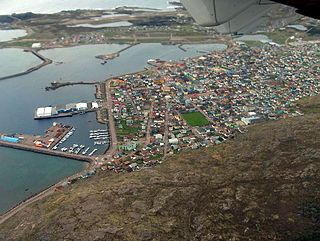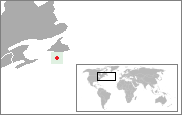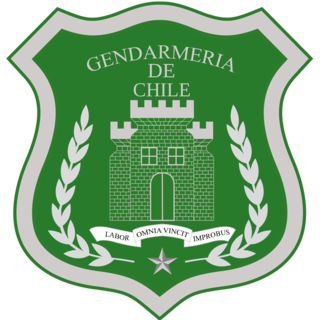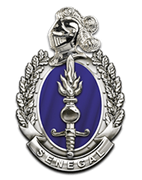Related Research Articles

The Luxembourg Armed Forces are the national military force of Luxembourg. The army has been a fully volunteer military since 1967. As of December 2018, it has 939 personnel.

Saint Pierre and Miquelon, officially the Territorial Collectivity of Saint-Pierre and Miquelon, is a self-governing territorial overseas collectivity of France in the northwestern Atlantic Ocean, located near the Canadian province of Newfoundland and Labrador. An archipelago of eight islands, St. Pierre and Miquelon is a vestige of the once-vast territory of New France. Its residents are French citizens; the collectivity elects its own deputy to the National Assembly and participates in senatorial and presidential elections. It covers 242 km2 (93 sq mi) of land and had a population of 6,008 as of the March 2016 census.

Saint Pierre and Miquelon is a French overseas collectivity in the Western Hemisphere and the Northern Hemisphere. It consists of an island archipelago, off the coast of Newfoundland, near North America. The collectivity shares a maritime boundary with Canada.
The politics of Saint Pierre and Miquelon take place in the framework of a parliamentary representative democratic French overseas collectivity, whereby the President of the Territorial Council is the head of government, and of a multi-party system. Executive power is exercised by the government.
Sergeant is a rank in use by the armed forces of many countries. It is also a police rank in some police services. The alternative spelling, serjeant, is used in The Rifles and other units that draw their heritage from the British light infantry. Its origin is the Latin serviens, 'one who serves', through the Old French term serjant.

Miquelon-Langlade is the larger but less populated of the two communes (municipalities) making up the French overseas collectivity of Saint Pierre and Miquelon, located to the south of Newfoundland in the Gulf of St. Lawrence. It consists of three geological islands: Miquelon, Langlade and Le Cap, connected with tombolos. The communal seat is the settlement of Miquelon, on the northern tip, where the entire island's permanent population of 580 is located. Miquelon Airport provides flights to Montreal and to nearby Saint-Pierre Airport.

The National Police, formerly known as the Sûreté nationale, is one of two national police forces of France, the other being the National Gendarmerie. The National Police is the country's main civil law enforcement agency, with primary jurisdiction in cities and large towns. By contrast, the National Gendarmerie has primary jurisdiction in smaller towns, as well as in rural and border areas. The National Police comes under the jurisdiction of the Ministry of the Interior and has about 145,200 employees. Young French citizens can fulfill their mandatory service in the police force.

The Maritime Gendarmerie is a component of the French National Gendarmerie under operational control of the chief of staff of the French Navy. It employs 1,157 personnel and operates around thirty patrol boats and high-speed motorboats distributed on the littoral waterways of France. Like their land-based colleagues the Gendarmes Maritime are military personnel carry out policing operations in addition to their primary role as a coast guard service. They also carry out provost duties within the French Navy.

Saint-Pierre is the capital of the French overseas collectivity of Saint Pierre and Miquelon, off the coast of the Canadian island of Newfoundland. Saint-Pierre is the more populous of the two communes (municipalities) making up Saint Pierre and Miquelon.

The National Gendarmerie is one of two national law enforcement forces of France, along with the National Police. The Gendarmerie is a branch of the French Armed Forces placed under the jurisdiction of the Ministry of the Interior, with additional duties from the Ministry of Armed Forces. Its responsibilities include policing smaller towns, suburbs and rural areas, crowd and riot control, criminal investigation, including cybercrime. By contrast, the National Police is a civilian law enforcement agency that is in charge of policing cities and larger towns. Because of its military status, the Gendarmerie also fulfills a range of military and defence missions. The Gendarmerie has a strength of around 102,269 people.

The Mobile Gendarmerie (GM) is a subdivision of the French National Gendarmerie whose main mission is to maintain public order and general security. Contrary to the Departmental Gendarmerie, whose jurisdiction is limited to specific parts of the territory, the Mobile Gendarmerie can operate anywhere in France and even abroad as the Gendarmerie is a component of the French Armed Forces. Although the term "mobile" has been used at different times in the 19th century, the modern Mobile Gendarmerie was created in 1921.

The following is an alphabetical list of topics related to the French territorial collectivity of Saint Pierre and Miquelon.

The Chilean Gendarmerie, is the title of Chile's uniformed national prison service military. The service evolved when Chilean Army units were given police and prison duties under president Carlos Ibáñez del Campo, a move that also created the Carabineros de Chile police force.

The National Gendarmerie is one of two national law enforcement force of Senegal, serving as a branch of the Armed Forces of Senegal. As a military unit, it is placed under the jurisdiction of the Ministry of Armed Forces. It is similar in nature to their French counterparts as well as the State Police in the U.S. It is one of the largest African contributors to peacekeeping missions around the world.
The King's Birthday Honours 1938 were appointments in many of the Commonwealth realms of King George VI to various orders and honours to reward and highlight the meritorious work of his subjects in those countries. The appointments were made to celebrate the King's official birthday and for the United Kingdom and Colonies were announced on 7 June 1938.
The 1946 King's Birthday Honours, celebrating the official birthday of King George VI, were announced on 13 June 1946 for the United Kingdom and British Empire.
The 1940 Birthday Honours were appointments by King George VI to various orders and honours to reward and highlight good works by citizens of the British Empire. The appointments were made to celebrate the official birthday of The King, and were published on 9 July 1940.

The National Gendarmerie of Gabon is the national police force of Gabon responsible for law enforcement in Gabon. It is under the direct command of the President of Gabon. The Gendarmerie is also in charge of the Gabonese Republican Guard.
References
- 1 2 3 4 "Portail internet des services de l'Etat: La Gendarmerie Nationale". Archived from the original on 2012-04-12. Retrieved 2013-02-08.
- 1 2 3 4 5 6 7 8 9 10 11 12 13 14 15 16 17 18 19 20 21 22 23 24 25 26 27 28 29 30 31 32 "Saint-Pierre et Miquelon - Portail Cheznoo.net".
- ↑ "French patrol ship Fulmar: Port visit to Rimouski and Québec".
- ↑ "Atlantique Nord-ouest : le Fulmar coopère avec les forces de la région". Ministère des Armées. 28 April 2023.
